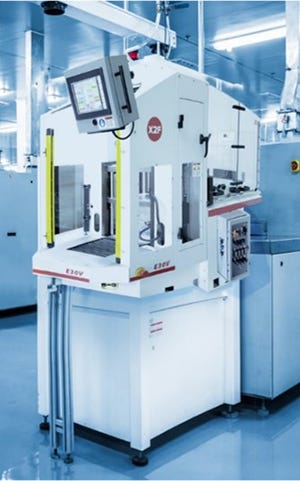The new category of molding technology benefits, in particular, delicate electronics encapsulations and automotive lighting applications with complex geometries.
June 16, 2021

X2F is commercializing a new category of molding technology that leverages controlled viscosity (low pressure) and a patented pulse-packing approach to create high-value components for a variety of industries. X2F has also announced the hiring of a key technical person, Ken Jacob, a plastics industry veteran and technology expert, as the company looks to expand its reach.
|
The X2F system uses controlled viscosity (low pressure) and a patented pulse-packing approach to create high-value components. |
Rick Fitzpatrick, X2F founder and Chief Technology Officer, told PlasticsToday that the company’s goal is to perform complex molding using difficult-to-mold materials. “We didn’t start this company to attack the problem of viscosity but to get better control over injection pressure by bringing the material to a low and flowable viscosity,” explained Fitzpatrick. “Our extrusion screw is designed for this process that we’ve developed over the past 15 years.”
X2F is also molding PEEK with 60% carbon fiber or 60% glass filler, resulting in more complex, stronger, and durable parts with enhanced performance. “We are doing what no other compounders are doing today,” said Fitzpatrick. “We’re able to add these fillers at the machine, and that brings our customers greater flexibility in their molding capabilities because these materials can’t be pelletized.”
For optical applications such as mobile phone lenses, the process produces parts with reduced birefringence and anisotropic shrink. In automotive lighting applications, the X2F process can produce complex geometries, thicker lenses, and larger shapes. X2F puts the material into the mold cavity at high pressure “without abusing it,” Fitzpatrick explained. “We’re molding automotive headlamp lenses, virtual reality lenses using materials ranging from acrylic and PC to COC and COP, very complex lens polymers costing up to $100/lb. When you mold these materials, you need to mold them without birefringence, which is caused by stress as the molecules try to get back to their natural position. We’re molding these materials without stress and no sink.”
With X2F’s process, materials typically needing 20,000 to 30,000 psi injection pressure can be run on a conventional machine with 1,000 to 5,000 psi in the mold cavity. “We get there from an entirely different direction,” explained Fitzpatrick. “We begin flowing and gradually build pressure, while not abusing the polymer in the process.”
For example, X2F can mold a 35-gram shot size of 75%-filled PEEK in a 4-ton clamp molding machine, competing against 200- to 250-ton machines, doing it at 10% of the power typically used. When a conventional molder processes filled or unfilled PEEK using 5 to 6 tons of clamp per square inch, X2F can achieve the same result at about 15% of that. “We need 1,000 pounds of clamp per square inch compared to the 12,000 lbs per square inch most people use for heavily filled materials,” Fitzpatrick said.
|
Materials typically needing 20,000 to 30,000 psi injection pressure can be run on a conventional machine with 1,000 to 5,000 psi in the mold cavity using X2F technology. |
This process can be used in “very delicate” electronics encapsulation applications due to the tight control of temperature and pressure in the mold cavity, said Fitzpatrick, explaining that in encapsulated electronics the X2F process offers superior performance against moisture, temperature, and environmental conditions as compared to conformal coating, potting, or other low-pressure approaches.
Examples include using X2F technology to help waterproof consumer electronics, such as watches and mobile phones, or to protect circuitry in industrial and automotive applications that need enhanced reliability. The X2F process also allows for fewer production steps, dramatically improved yields, shorter cycle times, and the processing of new materials with advanced properties.
“We’re quietly working along, defining what can and can’t be done with plastics and what is injection moldable. We’re defining where the plastic industry is going, rather than where it is,” Fitzpatrick said. “We’ve not come across a single material that we can’t mold.”
About the Author(s)
You May Also Like






